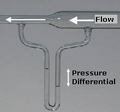Venturi effect facts for kids
The Venturi effect is a cool science idea about how liquids or gases (which we call fluids) move through a tube that changes size. Imagine water flowing through a hose. If you squeeze the hose to make it narrower, the water speeds up, right? That's similar to the Venturi effect!
When a fluid flows into a narrower part of a tube, its velocity (speed) goes up. At the same time, the pressure of the fluid goes down. This happens because of something called conservation of energy. It's like the fluid is trading its pressure energy for speed energy. This effect is a great example of Bernoulli's principle, which explains how fluid speed and pressure are related.
Contents
What is the Venturi Effect?
The Venturi effect describes what happens when a fluid moves through a tube that gets smaller and then bigger again. Think of a pipe that has a squeezed middle section.
- When the fluid reaches the narrow part, it has to speed up to get through.
- As it speeds up, its pressure drops.
- Once the fluid leaves the narrow part and enters the wider section again, it slows down, and its pressure goes back up.
This idea is named after an Italian scientist named Giovanni Battista Venturi, who studied it a long time ago.
How Does It Work?
The Venturi effect is a direct result of the Bernoulli's principle. This principle states that for a fluid flowing smoothly, an increase in its speed happens at the same time as a decrease in its pressure. It's all about how energy is conserved in the moving fluid.
Imagine the fluid has a certain amount of total energy. This energy can be in different forms:
- Pressure energy: The push the fluid exerts.
- Kinetic energy: The energy of its movement (speed).
- Potential energy: Energy due to its height (less important in horizontal tubes).
When the fluid enters a narrow section, it has to move faster. This means its kinetic energy increases. To keep the total energy the same (because of conservation of energy), the pressure energy has to decrease. So, faster flow means lower pressure.
Where Do We See the Venturi Effect?
The Venturi effect isn't just a science experiment; it's used in many real-world things!
Car Carburetors
Older cars used a part called a carburetor. Inside, air would flow through a narrow section. This would make the air speed up and its pressure drop. The lower pressure would then suck fuel into the air stream, mixing it perfectly for the engine.
Spray Bottles
Many spray bottles use the Venturi effect. When you push the trigger, a pump forces air through a narrow tube. This creates a low-pressure area, which pulls the liquid up from the bottle and sprays it out as a fine mist.
Airplane Wings
While not a direct Venturi tube, the shape of an airplane wing (an airfoil) uses a similar principle. Air flows faster over the curved top of the wing than the flatter bottom. This creates lower pressure above the wing and higher pressure below it, which helps lift the plane into the air.
Medical Devices
Some medical devices, like nebulizers, use the Venturi effect to turn liquid medicine into a fine mist that patients can breathe in.
Images for kids
See also
 In Spanish: Efecto Venturi para niños
In Spanish: Efecto Venturi para niños




